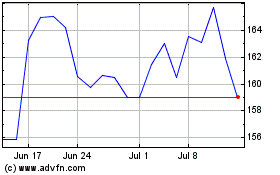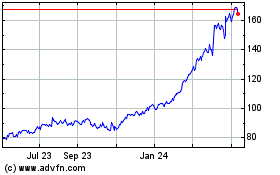GE Healthcare Strengthens R&D Efforts in Alzheimer’s Disease
April 13 2012 - 2:00AM
Business Wire
GE Healthcare (Chalfont St. Giles, U.K.; John Dineen, president
and CEO), Medical Diagnostics business has entered into research
collaboration with Clino Ltd. (Sendai, Miyagi Prefecture; Noriaki
Satake, president), a venture by Tohoku University to discover in
vivo imaging tracers for tau proteins that accumulate in the brains
of Alzheimer’s Disease patients.
Yukitsuka Kudo, head of imaging at Clino and a professor at
Tohoku University Innovation of New Biomedical Engineering Center,
explains the significance of the research project: “The development
of radiotracers for tau examinations involves a number of hurdles,
and we’re hoping that our joint research with GE’s worldwide
operation will enable us to serve as a bridge that will speed the
further evolution of these pharmaceuticals, as well as their
progression through clinical and therapeutic trials.”
Professor Hiroyuki Arai of the Institute of Development, Aging
and Cancer at Tohoku University is the leading domestic researcher
on Alzheimer’s and the first person in the world to succeed in
detecting tau proteins in cerebrospinal fluid and argue for their
significance as surrogate biomarker. Dr. Arai stresses the crucial
nature of tau imaging in Alzheimer’s diagnoses: “Research data on
PET imaging of amyloid are currently being accumulated, and the
thinking now is that if we can conduct additional tau PET imaging
on healthy subjects who have tested positive in amyloid PET exams,
it will become possible to identify those with high risk of
converting to Alzheimer’s. This could lead to diagnoses of
pre-clinical stage Alzheimer’s disease’, which may enable
prevention before the onset of symptoms.”
As of 2010, there were a total of approximately 35.6 million
confirmed cases of Alzheimer’s disease worldwide, and projections
indicate that the total will reach 115.4 million cases by 2050.1 In
Japan, which is leading the world in terms of the advance of
population aging, there were approximately 2 million cases in 2010,
with a projected 3.25 million expected by 20202. Alzheimer’s is
thought to be caused by accumulations within the brain of beta
amyloid and tau proteins. Beta amyloid plaques are thought to begin
accumulating within the brain 30 years before symptoms appear, and
tau proteins ten years prior.
“The collaboration we are announcing today is part of our
ongoing effort to understand and identify Alzheimer’s disease in
its very early stages,” said Pascale Witz, CEO of GE Healthcare
Medical Diagnostics. “The combination of our different business
offerings positions us well to offer an integrated global
diagnostics solution for the next generation of therapies. We are
working with pharma to understand their strategic needs and design
solutions accordingly.”
GE Healthcare already provides the worldwide supply of 11C-PIB,
a PET contrast agent for beta amyloid detection developed by the
University of Pittsburgh in 2003 and for which GE Healthcare has
obtained exclusive rights of utilization. In addition, if the new
joint venture with Clino results in the identification of agents
that can distinguish tau accumulation, it will become possible to
diagnose the level of severity of Alzheimer’s symptoms. It would
also be expected to enable the development of drugs by the
pharmaceutical industry and research institutes that would target
tau proteins on the molecular level.
Further, GE Healthcare and Clino will consider collaborations
with other companies and research institutes developing tau protein
therapies. These are among the many efforts aimed at contributing
to the early, precise diagnosis and treatment of Alzheimer’s.
In addition to development of pharmaceuticals, GE Healthcare is
currently providing diagnostic imaging devices such as PET and
magnetic resonance imaging (MRI) scanners in support of the
detection of cognitive diseases including Alzheimer’s. They have
also been supporters from the outset of the Alzheimer’s Disease
Neuroimaging Initiative (ADNI), a clinical observational research
project designed to generate standards for Alzheimer’s diagnosis
and assessment of the degree to which the disease has progressed.
They are moving ahead with a diverse range of efforts toward the
imaging evaluation of cognitive diseases around the world including
in Japan.
Notes
1. Source: “International Alzheimer’s Disease Report,”
Alzheimer’s Disease International,
http://www2f.biglobe.ne.jp/~boke/newsadi.htm
2. Source: “Epidemiological Statistics for Japan,”
Hiroshi Shimokata, Nippon Rinsho Extra Ed. on Dementia Studies 3
2004; 62, No. 4, pp. 121-125.
About GE Healthcare
GE Healthcare provides transformational medical technologies and
services that are shaping a new age of patient care. Our broad
expertise in medical imaging and information technologies, medical
diagnostics, patient monitoring systems, drug discovery,
biopharmaceutical manufacturing technologies, performance
improvement and performance solutions services help our customers
to deliver better care to more people around the world at a lower
cost. In addition, we partner with healthcare leader, striving to
leverage the global policy change necessary to implement a
successful shift to sustainable healthcare systems.
Headquartered in the United Kingdom, GE Healthcare is a unit of
General Electric Company (NYSE: GE). Worldwide, GE Healthcare
employees are committed to serving healthcare professionals and
their patients in more than 100 countries. For more information
about GE Healthcare, visit www.gehealthcare.com.
For our latest news, please visit
http://newsroom.gehealthcare.com
About CLINO
Clino was established to commercialize medical research
engineering products from four TUBERO (Tohoku University
Biomedical Engineering Research Organization), which was one of the
COE(Center Of Excellence) programs started in 2003 by MEXT(*).
Clino's company philosophy is to contribute to the
society through "clinical innovation".
(*):Ministry of Education, Culture, Sports, Science and
TechnologyCompany URL http://www.clino.org/
GE Aerospace (NYSE:GE)
Historical Stock Chart
From Mar 2024 to Apr 2024

GE Aerospace (NYSE:GE)
Historical Stock Chart
From Apr 2023 to Apr 2024
